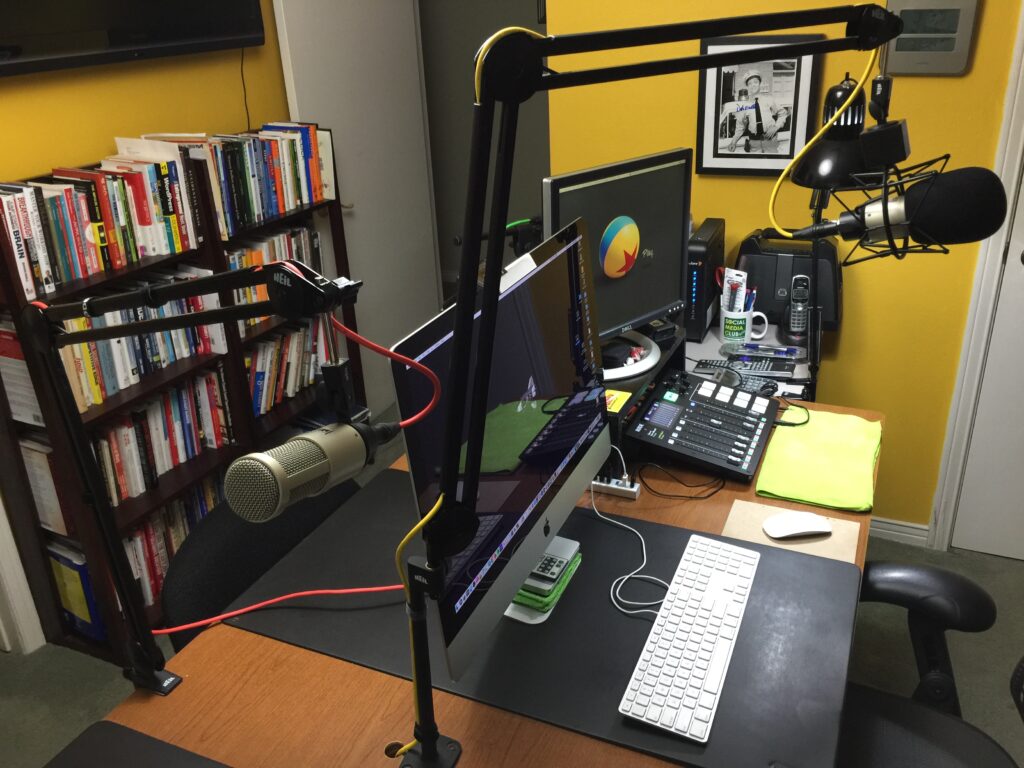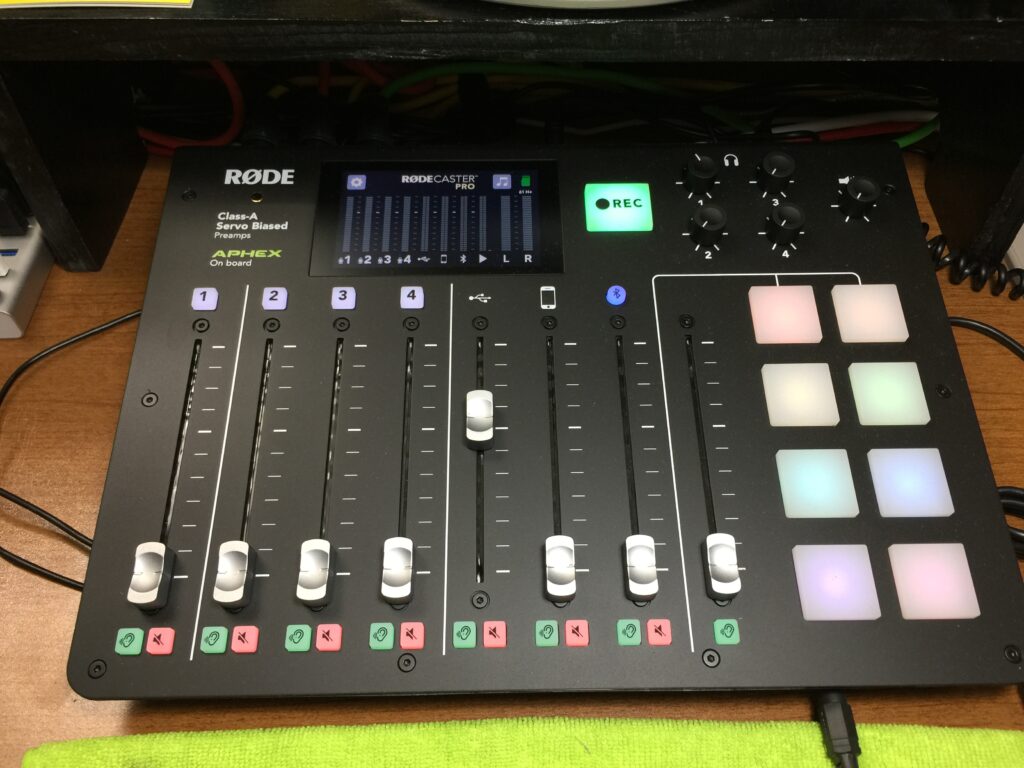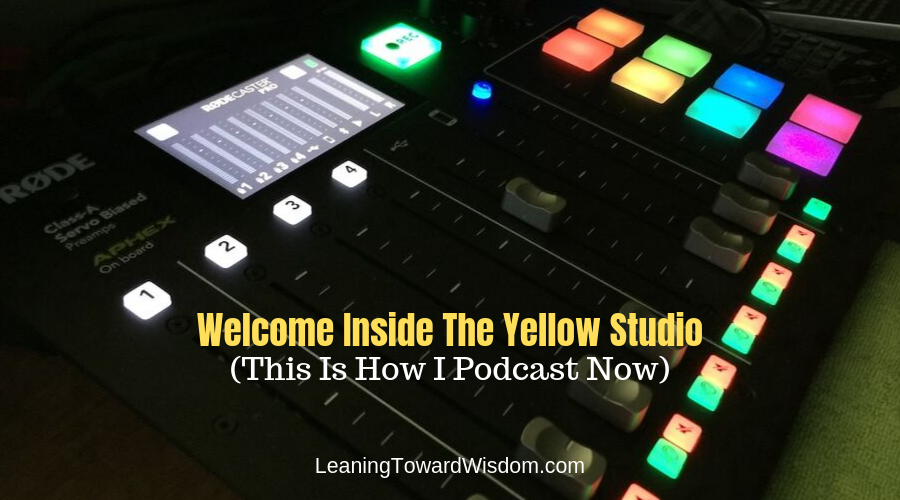Podcast: Play in new window | Download (Duration: 29:55 — 27.6MB)
Subscribe: Apple Podcasts | Spotify | iHeartRadio | Email | RSS | More

It only took one day. To dismantle the Yellow Studio.
It took a small generous community of podcast supporters. To help make it become a reality.

The donors are now on a special email list where I’ve been keeping them updated. This group will continue to remain special and enjoy some inside updates. It’s just one small way I can thank you for making the Rode Rodecaster Pro possible.
Now, let’s geek out just a little bit for those of you interested in the technicalities of podcasting. For the rest of you, bear with me.
Years ago when I built The Yellow Studio there were basically two methods or workflows used in podcasting. The first was by far the most popular because it was the least expensive route, RECORDING. To be fair, all podcasts are recorded. That became the very definition of the medium – serialized, subscribable audio content. People could listen at will. On their own timetable. It was all pretty slick and we were as excited to get an email as we were to get a new episode of our favorite podcast.
RECORDING methodology just required a microphone and some software (much of it free). To gussy up the sound you needed fancier software. This also meant you spent time editing. The first recording wouldn’t necessarily be the final version. This workflow demanded significant after-the-fact work.
BROADCASTING was the other methodology. This wasn’t nearly as popular because it required hardware. And hardware was (still is) expensive. The benefits are high. The minute you hit “record” the sound is recorded digitally exactly as it will sound when listeners hit “play.” Other than editing for content – not for sound quality – it’s more of a “what you hear is what you get” process.
I instantly wanted to go the BROADCAST route because I preferred to put my work in ahead of hitting the record button. It wasn’t about avoiding work. At least not for me. It was about when to do that work. I wanted to spend time doing the work ahead of recording, not afterward.
This meant investing in gear. Thankfully, I had the ability to make the investment. And I had some expert help in figuring out what I should get.
I embarked on finding and assembling equipment that was mostly broadcast quality. Built to withstand hours and hours of non-stop operating without any problems. In short, I was building a small 2-mic station with just about everything other than a transmitter. My transmitter was going to be the Internet.
The microphones came first. Two Heil Sound PR40 microphones. Others picked them because of longtime broadcaster/podcaster, Leo Laporte. Leo is a tech guy who has enjoyed radio and Internet success. He used the Heil PR40.
Well, I didn’t know of Leo when I got the PR40s. But I had heard of Bob Heil because I was very into music. I also had (still have it) a fondness for the sound of great condenser microphones, but I knew my space wouldn’t be ideal for a condenser mic because they pick up EVERYTHING. My space was going to be pretty solid for recording, but it wasn’t going to be like a professional voice booth (commonly used by voiceover artists) or like a professional recording studio with extensive sound isolation. Enter the PR40. Its large diaphragm has condenser mic qualities in a dynamic mic.
Two Heil PR40s, each on its own boom arm and mounted inside its own shock mount. Those were the first items purchased.
Next came the coveted Aphex 230 microphone preamps. Radio people and voiceover artists alike have run to the Aphex sound for years. Microphones have to be plugged into something that can provide enough gain so you get sound. Enter the preamps.
The Aphex 230s – one for each mic – came next. They were among the first items installed in the six-unit gear rack. These units included things like noise gates, compressors, limiters, deessers and all sorts of sonic goodies to make your voice sound outstanding.
The Aphex units were great for making me sound terrific, but what about people coming through on Skype or some other Internet service? I had a TC Electronic Finalizer Express which put a nice bit of compression over everything going through the system. More knobs, dials and light than you could shake a stick at, but it’s a terrific piece of gear.
Phone calls? What about taking phone calls? I wanted to do what radio stations do – patch phone calls directly into my recordings. Enter the staple piece in every radio station in the land (at the time), a Telos One. One button activates it, but the electronics inside the box provide telephonic magic. It was connected to my landline, but we went VOIP, then it was connected to that.
All of that went through a small broadcast quality mixer made by Broadcast Tools, a Promix 12. Built like a tank, the Promix had long-throw faders (that means they’re large and the sound range is more subtle than short-throw faders). The Promix12 is a 2 mic mixer, but has some cool broadcasting features like built-in mix/minus so I could patch my Telos One into channel 4 and not fret about the person on the phone hearing themselves echo. No special engineering skills required.
But my system was a fully balanced audio system. That meant, it was professional-grade and used only XLR or insert cables made with coax and professional connectors. What about connecting output from a laptop, or a phone, or an iPad? I had no way to do that until I invested in a Yamaha MG124c mixer, another 12 channel mixer that had RCA inputs (something the Promix12 lacked). Now I could take the output of the Yamaha and patch it into the Promix12 (using a single channel on the Promix12).
To route all that into my computer required an interface of some sort. I had two different versions of a firewire interface made by Presonus. Firewire was more commonplace when I began. It has since declined in popularity, but I went that route at first because the speed was much faster than USB.
For headphone management, I got an Aphex 454 Headpod. Sounded GREAT! It provided ample volume to 4 separate headphones, each with a dedicated volume control.
Cable management was a challenge right off the bat. And figuring out the cabling was a chore all its own.
I never did figure out the sheer footage of cables used to connect all this stuff, but it was RIDICULOUS. The number of connections was also ridiculous because the signal chain was anything, but straight, short and simple. Cables going into one thing, out of that thing and into some other thing.
I figured that’s how it would always be. There just wasn’t any other way to have the workflow I wanted. BROADCAST.
Heat.
Let’s not overlook the heat produced by a rack of gear like that. Temperatures here inside The Yellow Studio were likely 2-5 degrees hotter than any other room. Fine during the winter. Not so great during the summer.
Power.
We’re not talking BIG power suckage, but everytime there was a thunderstorm or risk of power going out…I’d scramble to unplug the rack (even though it was all going through good quality power management to protect it). I wasn’t going to risk a brown out or black out from wrecking any equipment.
Then things changed.
It was the summer of 2015. Rode, an Australian company, acquired Aphex, one of my favorite suppliers. I didn’t quite know what Rode might do with Aphex, but I loved Rode mics (I have a Rode NTG2 shotgun mic in my mic locker) and I loved Aphex stuff.

By the time 2019 rolled around Rode blew the lid off the podcasting world with a device that incorporated Aphex sound characteristics. Dubbed Rodecaster Pro it proposed to be a full podcasting studio based on 4 microphone channels. But wait. It would also have a channel built in to hardwire a smartphone, and if that weren’t cool enough…it’d have a Bluetooth channel, too. Additionally, it would have an 8-key sound cart pad (for sound effects; something I was doing through software on a laptop, phone or iPad). And it would have a 4-channel headphone amp, each channel with a dedicated volume control.
Suddenly, there was a device – a single device – that would do everything my studio would do. One piece of gear would replace all the stuff I’ve mentioned. No, I’d lose all the knobs, lights and some flexibility in the adjustments – but I’d lose all those cables and all the complexity. One cable going from one mic into the Rode and that’d be it. One cable from the iPhone to the Rode. One pair of headphones plugged into each channel. Simple. Straightforward.
But what about the sound? That had always been my preoccupation. I wanted the sound inside The Yellow Studio to be spectacular and thanks to my set up, it was.
I watched every YouTube review of the Rode Rodecaster Pro. I listened carefully. I knew the ease of operation of the product meant I would lose all the little fine nuances of sound adjustments, but this is podcasting I figured. This isn’t music recording. And this is spoken word, not singing. How nuanced does the sound really need to be? I concluded that any loss of adjustments I might forfeit in the Rode would be more than made up for in having everything I needed in a single piece of gear!
Then there were the firmware updates released by Rode. Rode was listening to customers. They had two major firmware updates before I pulled the trigger and bought mine. Multi-track recording. And a host of other improvements were pushed to the unit via these updates.
Not Looking Back
You don’t see or hear many people talk about it, but the Rodecaster Pro accomplished what I was able to with my rack. Livestreaming audio quality is identical to the recordings. I’m just now seeing livestreaming people pick up on the improvement capable via the Rodecaster Pro.
Get me on a Skype call, or a Zoom web conference and I’m going to sound just as good as my recordings. All thanks to the Rode Rodecaster Pro.

A single USB connection to my Apple iMac and I’m done.
Four mics. Four cables into the Rodecaster Pro.
Four headphones.
One cable to the iPhone.
That’s it. And I give up nothing in connectivity and flexibility.
I can take phone calls.
I can record by myself or with a few friends.
I can input sounds via the soundcart buttons, the computer or even my iPhone or iPad.
I’ve got volume knobs for each headphone as well as a master volume control.
If the unit isn’t perfect it’s awfully close! Just like you, the listeners of my podcast. You’re not the perfect podcast audience, but you’re awfully close.
Thank you!
Randy

Pingback: Goodbye To The Yellow Studio Version 2.0 - LEANING TOWARD WISDOM